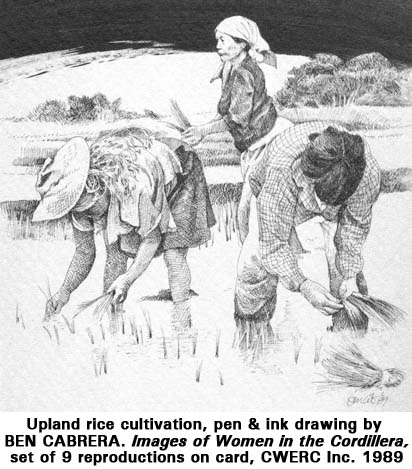KASAMA Vol. 24 No. 3 / July-August-September 2010 / Solidarity Philippines Australia Network
Indigenous People's Traditional Rice Varieties Making a Comeback
 Saturday, 11 September 2010
Saturday, 11 September 2010
Traditional rice varieties once grown and nurtured by indigenous peoples are making a comeback because of the importance of their genes that are necessary in breeding rice for the future.
This was made known when this author, director of the Cordillera Ecological Center (PINE TREE) was invited to speak at the International Rice Research Institute (IRRI), which has spearheaded world research in rice technology since the early 1950s.
For sometime, there was a growing fear that hybrid rice will altogether eliminate traditional rice varieties. Today, current conditions prove that traditional rice varieties are here to stay and are necessary for rice evolution.
IRRI has started giving back to farmers and communities small packets of traditional rice varieties that will be planted and serve as planting materials. Technological assistance is likewise provided by IRRI for those who wish to plant once again traditional rice varieties. “IRRI has now realized that traditional rice varieties need to be put back into farmers’ fields. IRRI is doing just that—giving back traditional rice varieties it has kept for so many years in its high tech seedbank, the environmental group PINE TREE bared.
Outstanding characteristics of traditional rice varieties, like resistance to pests and diseases and high yielding capability, are genetically engineered with other characteristics of other rice varieties to serve as building blocks for new rice varieties.
PINE TREE is working with United Nations Development Program Global Environment Facility (UNDP-GEF) in the Philippines to protect indigenous peoples traditional rice varieties.
In Karao, Bokod, Benguet, farmers with assistance from PINE TREE have saved and continue to sustain the use of seven traditional rice varieties by establishing a rice seedbank shared by community people. The seven traditional varieties now being conserved by the Karao farmers are found nowhere else in the Philippines.
PINE TREE is linking with IRRI to get traditional rice seeds especially upland un-irrigated varieties and bring these back to farmers’ fields because these are vital for food security and in providing future genetic material.
For many years, hybrid rice was promoted in the Philippines especially by the government believing it was the answer to the growing population. But while it improved production, it required expensive chemical inputs that endangered not only humans but also altered the ecosystem adversely. Today, the country is the leading rice importer in Asia and it has lost 90 per cent of all its traditional rice varieties, Bengwayan said.
The Philippine government insisted on pushing for hybrid rice even with its past dismal failure, especially so because the Department of Philippine Agriculture signed an agreement with IRRI to a US$216 million project for the production of subsidized hybrid and certified seeds, he added. This happened even though the World Bank concluded that the Philippines hybrid rice program had not produced “much net social benefit’.
The reality, PINE TREE says, is that food giant corporations, Philippine corrupt officials and food corporations stand to gain illicitly from all these. The main beneficiary of the various hybrid rice schemes, for instance, is SL Agritech, owned by Filipino Chinese businessman Henry Lim. In 2006, SL Agritech supplied 65 per cent of the hybrid rice seeds purchased through the country’s hybrid rice programme earning the company more than US$4 million. It also was a time when the Philippine government official of the Department of Agriculture JocJoc (
Oh what a joke indeed to Filipino farmers!) Bolante romped away with millions of pesos worth of fertilizers intended to support the program, PINE TREE explained.
While traditional rice varieties were forgotten in the past decades, they are the “heart and soul of rice”. They require little fertilizer and no chemical inputs, now blamed for the degeneration of farmlands in many parts of the world. Traditional rice varieties are more nutrient-rich, tastier and friendlier to the soil. They allow farmers to protect their soil and ecosystem and have control of the seeds that their forefathers have reared for centuries.
PINE TREE is encouraging farmers to keep their own seeds and bank these to prevent the seeds from being pirated by big multinational groups. Seedsaving or banking is the best protection that indigenous peoples have against biopiracy, PINE TREE said.
The indigenous peoples in the Cordillera region own some of the best sustainable and indigenous practices in agriculture and forest conservation.
For instance, the IPs from mountain Province practice sustainable farming by using “lumeng” (mixture of decomposed rice straw with pig manure) and wild sunflower (Tithanium diversifolium) stalks as basal manure and green manure before planting traditional rice varieties. They also incorporate the brown-green nitrogen fixing algae Azolla which fixes nitrogen from the atmosphere and delivers this for rice use as nitrogen fertilizer.
In forest conservation, the indigenous peoples of Sagada, Besao, Bauko and Tadian practice the “lakon” forest system which enables forests to be conserved and protected.
In Ifugao, the IPs there practice the “muyung” and “pinugo” agroforestry systems that incorporate timber with fruits trees, rice, crops and livestock to ensure ecological balance.
But as modernization creeps in, some of these IP indigenous knowledge are starting to crumble. It may not be long before these are forgotten, unless immediate measures are taken up to popularize these with the new generation.

 Home | Aims and Objectives of Solidarity Philippines Australia Network | About Kasama
Home | Aims and Objectives of Solidarity Philippines Australia Network | About Kasama 